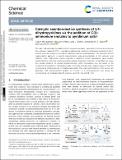Files in this item
Catalytic enantioselective synthesis of 1,4-dihydropyridines via the addition of C(1)-ammonium enolates to pyridinium salts
Item metadata
| dc.contributor.author | McLaughlin, Calum | |
| dc.contributor.author | Bitai, Jacqueline | |
| dc.contributor.author | Barber, Lydia | |
| dc.contributor.author | Slawin, Alexandra | |
| dc.contributor.author | Smith, Andrew David | |
| dc.date.accessioned | 2021-08-17T13:30:03Z | |
| dc.date.available | 2021-08-17T13:30:03Z | |
| dc.date.issued | 2021-08-06 | |
| dc.identifier | 275345276 | |
| dc.identifier | 7143aab0-1a34-4dea-bd0a-c656fb101d2e | |
| dc.identifier | 000686800600001 | |
| dc.identifier | 85115730140 | |
| dc.identifier.citation | McLaughlin , C , Bitai , J , Barber , L , Slawin , A & Smith , A D 2021 , ' Catalytic enantioselective synthesis of 1,4-dihydropyridines via the addition of C(1)-ammonium enolates to pyridinium salts ' , Chemical Science , vol. Advance Article . https://doi.org/10.1039/D1SC03860E | en |
| dc.identifier.issn | 2041-6520 | |
| dc.identifier.other | ORCID: /0000-0002-2104-7313/work/98487552 | |
| dc.identifier.other | ORCID: /0000-0002-9527-6418/work/98487670 | |
| dc.identifier.uri | https://hdl.handle.net/10023/23788 | |
| dc.description | Authors thank the EPSRC (EP/M508214/1, C.M.) for funding. A.D.S. thanks the Royal Society for a Wolfson Research Merit Award. | en |
| dc.description.abstract | The regio- and stereoselective addition of C(1)-ammonium enolates – generated in situ from aryl esters and the isothiourea catalyst (R)-BTM – to pyridinium salts bearing an electron withdrawing substituent in the 3-position allows the synthesis of a range of enantioenriched 1,4-dihydropyridines. This represents the first organocatalytic approach to pyridine dearomatisation using pronucleophiles at the carboxylic acid oxidation level. Optimisation studies revealed a significant solvent dependency upon product enantioselectivity, with only toluene providing significant asymmetric induction. Using DABCO as a base also proved beneficial for product enantioselectivity, while investigations into the nature of the counterion showed that co-ordinating bromide or chloride substrates led to higher product er than the corresponding tetrafluoroborate or hexafluorophosphate. The scope and limitations of this process are developed, with enantioselective addition to 3-cyano- or 3-sulfonylpyridinium salts giving the corresponding 1,4-dihydropyridines (15 examples, up to 95:5 dr and 98:2 er). | |
| dc.format.extent | 11 | |
| dc.format.extent | 1410643 | |
| dc.language.iso | eng | |
| dc.relation.ispartof | Chemical Science | en |
| dc.subject | QD Chemistry | en |
| dc.subject | DAS | en |
| dc.subject.lcc | QD | en |
| dc.title | Catalytic enantioselective synthesis of 1,4-dihydropyridines via the addition of C(1)-ammonium enolates to pyridinium salts | en |
| dc.type | Journal article | en |
| dc.contributor.sponsor | The Royal Society | en |
| dc.contributor.institution | University of St Andrews. School of Chemistry | en |
| dc.contributor.institution | University of St Andrews. EaSTCHEM | en |
| dc.identifier.doi | https://doi.org/10.1039/D1SC03860E | |
| dc.description.status | Peer reviewed | en |
| dc.identifier.grantnumber | WM140071 | en |
This item appears in the following Collection(s)
Items in the St Andrews Research Repository are protected by copyright, with all rights reserved, unless otherwise indicated.

